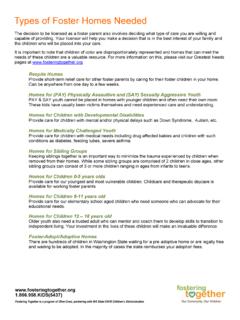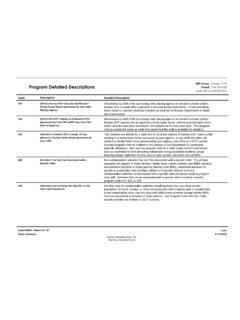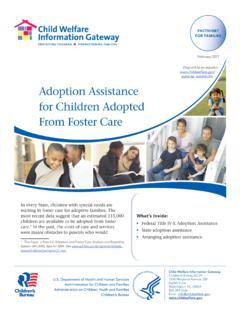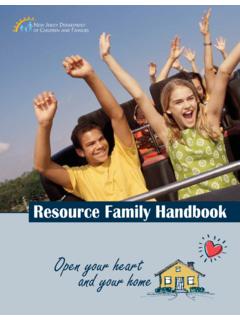Transcription of CERTIFICATE/DIPLOMA IN HEALTH AND SOCIAL …
1 HEALTH AND SOCIAL CARE SERVICESH/600/6886 LEVEL 2 UNIT 10 GUIDED LEARNING HOURS: 60 UNIT CREDIT VALUE: 10 OCR LEVEL 2 CAMBRIDGE TECHNICALCERTIFICATE/ diploma INHEALTH AND SOCIAL AND SOCIAL CARE SERVICESH/600/6886 LEVEL 2 UNIT 10 AIM OF THE UNITMany learners will be considering careers within HEALTH and SOCIAL care and this unit introduces them to the different types of service provision available within HEALTH and SOCIAL care. It considers how central government policies impact on local HEALTH and SOCIAL care provision. The unit aims to provide an overview of types of services, barriers which could affect access to services and differing job roles which exist within these services. PURPOSE OF THE UNIT Every service that exists within HEALTH and SOCIAL care belongs to one of four types of provision ie. Statutory, voluntary (third sector), private or informal. Learners will investigate the availability of HEALTH and SOCIAL care services in their local area and identify which services belong to which type of provision.
2 Learners will find out about how decisions made at central government level can impact on local services and affect the type, quality and quantity of services provided. HEALTH and SOCIAL care services are available in each locality and most people are able to use them without any difficulties. However there are reasons why some people are unable to access the services they need, these reasons are known as barriers. Learners will be able to consider the consequences for those individuals who are unable to access services due to cultural, psychological or geographical barriers for is a wide variety of job roles within HEALTH and SOCIAL care and this unit enables students to explore two different job roles and consider the skills and qualities required. They will also evaluate the different ways of training and or qualifying for a certain job role academic and vocational pathways. Learners will gain awareness that rarely do individuals work in isolation within HEALTH or SOCIAL care and this unit will enable them to develop an understanding of partnership and interagency working.
3 Learners will have the opportunity to consider how and why certain practitioners and agencies work within a partnership for the benefit of people who use and SOCIAL Care Services Level 2 Unit 101 Know key elements of HEALTH and SOCIAL care services2 Know barriers to accessing HEALTH and SOCIAL care services3 Understand principles of partnership in HEALTH and SOCIAL care 4 Understand requirements for job roles in HEALTH and SOCIAL careP1 identify the key elements of HEALTH and SOCIAL care servicesP2 identify the main barriers to accessing HEALTH and SOCIAL careP3 explain the benefits of interagency partnerships P4 explain the skills required for two different job roles in HEALTH and SOCIAL careM1 describe government policy that affects HEALTH or SOCIAL care servicesM2 describe possible effects of barriers on people who use servicesD1 review a case where effective partnership working could have, or did, affect the outcome for a person who uses HEALTH or SOCIAL care servicesD2 evaluate qualification pathways available for job roles in HEALTH or SOCIAL careASSESSMENT AND GRADING CRITERIAL earning Outcome (LO) Pass Merit Distinction The assessment criteria are To achieve a merit the To achieve a distinction the pass requirements for evidence must show that, the evidence must show this unit.
4 In addition to the pass that, in addition to the pass criteria, the learner is able to: and merit criteria, the The learner will: The learner can: learner is able to: CONTENTThe unit content describes what has to be taught to ensure that learners are able to access the highest which follows an details what must be taught as part of that area of which follows an is illustrative, it should be noted that where is used, learners must know and be able to apply relevant examples to their work though these do not need to be the same ones specified in the unit Know key elements of HEALTH and SOCIAL care services types of Provision: statutory, voluntary (third sector), private, informal Organisations involved in HEALTH and SOCIAL care: ( SOCIAL services, NHS; Strategic HEALTH Authorities; NHS Trusts; primary HEALTH care; secondary healthcare; tertiary HEALTH care; mental HEALTH trusts; children s trusts) HEALTH and SOCIAL care settings: hospitals, hospices, fostering arrangements, residential homes, day centres, Sure Start, domiciliary support; how different settings provide different services according to need Relevant and current government policy: (eg.)
5 Every Child Matters; Current NHS reforms, Surestart, Children Act; NHS and Care in the Community Act: Equality Act). 2 Know barriers to accessing HEALTH and SOCIAL care services Barriers: physical; financial; geographical location; cultural; individual preferences; SOCIAL class; psychological; language/communication. 3 Understand principles of partnership in HEALTH and SOCIAL care Partnership/inter-agency/multi-disciplin ary working ( users of services forums; voluntary and statutory sector liaison; integrated workforce agenda) Purposes/benefits: ( holistic approach; identification of common aims; promotion of integration; reduction of duplication; pooling of resources; maximisation of expertise; ensuring a consistent approach; overcoming barriers).4 Understand requirements for job roles in HEALTH and SOCIAL care Job role requirements of: ( nurse, mental HEALTH nurse, midwife, HEALTH visitor, nursing assistant, doctor, dentist, optician, pharmacist, dietician, paramedic, hospital play worker, occupational therapist, physiotherapist, medical laboratory technician, medical receptionist, cleaner, porter, SOCIAL worker, manager of residential home, care assistant, community workers, mobile meals staff, family support worker, assistant youth worker, counsellor, childminder, nursery nurse, nanny, foster parent, operating department practitioner) Care skills and qualities: active support; interpersonal skills; meeting basic needs; maintaining personal hygiene and mobility, appearance/dress, attitude, confidence, punctuality, empathy, ability to work with others; competence types of qualification or training pathway: (eg.
6 Vocational, academic, part-times courses, on the job training, evening classes) Advantages and disadvantages of qualification/training pathways: ( time involved, cost involved, promotion opportunities, work/life balance, life experiences, potential to earn money).5 HEALTH and SOCIAL Care Services Level 2 Unit 10 DELIVERY GUIDANCELO1 Know key elements of HEALTH and SOCIAL care servicesThis unit introduces new terminology and tutor input will be required to explain the different types of service provision. Relevant work experience placements could allow learners to identify how their placement fits in to the types of service provision. Once learners have grasped the different types of service provision, a town trail could be organised to allow learners the opportunity to find out what services exist within their locality. Examples of the four types of provision could be recorded on a town map and colour coded, to allow the information to be easily interpreted. Alternatively, learners could use the phone book, yellow pages or other local directories to find out and record what services exist.
7 Learners need to understand how each organisation provides for the people who use them. Guest speakers from different HEALTH and SOCIAL care settings could be invited into the classroom to explain how their service meets the needs of people who use it, what support they offer and how their service is influenced by government policy. To prepare for the visit learners could be asked to generate appropriate questions either through class discussion or small group work. Finding out about what services actually do allow learners to use their communication skills and their independent research skills for example, learners may contact a setting by telephone or e-mail to enquire about what support is offered. Learners could use the information collected to produce a wall display about the services offered by different HEALTH and SOCIAL care settings and which identifies government policies that affect the settings. If this is completed as a group work task it is important that individual contributions are identified for assessment Know barriers to accessing HEALTH and SOCIAL care servicesLearners need to be introduced to different categories of barriers to accessing HEALTH and SOCIAL care services, as listed in the unit content.
8 Learners could work in small groups with each group producing a spider diagram of examples for a given barrier; this could then be shared with the rest of the class. Case studies could be used to facilitate learning and learners could help produce these, building barriers into a given scenario. Following on from information collected in LO1, learners could identify possible barriers to access for a service or setting they have identified on the town map. Learners should be encouraged to consider aspects of PIES (physical, intellectual, emotional and SOCIAL ) when describing the possible effects on individuals of barriers to Understand principles of partnership in HEALTH and SOCIAL carePartnership working is a relatively new term and learners need to understand how services work together and why they work together. Learners could work in pairs or groups to prepare a presentation about partnership working. Tutors could provide each group with a scenario, or learners could write their own, based on an individual with a range of needs.
9 In their presentation learners should identify how services/practitioners work together to address the individual s needs and explain why the inter-agency way of working is of benefit. If possible, interviewing friends or family who have experienced a partnership approach when using services can give learners an opportunity to find out more about how it works from someone who has experienced it in Understand requirements for job roles in HEALTH and SOCIAL careThere are many ways of finding out about job roles within HEALTH and SOCIAL care, learners could begin by mind mapping a range of job roles in different HEALTH and SOCIAL care settings. A visit to the careers library if one is available can provide learners with a wealth of information on job roles. Guest speakers can also be invited in to talk about their role and the skills and qualities they require to meet the needs of people who use their service. The school nurse is often available for classroom talks and some learners may have family members employed within HEALTH or SOCIAL care services and are willing to provide a session about their job role.
10 The speaker would also be able to share the qualification pathway they went down to attain their role and inform learners of alternative pathways. There are many software packages available, such as Kudos and U-explore, in addition to the NHS careers website which enables learners to conduct independent research on job roles. Learners could produce leaflets or posters on skills required for certain job roles, providing all the basic information needed for an individual considering that ASSESSMENT SCENARIOS AND TASK PLUS GUIDANCE ON ASSESSING THE SUGGESTED TASKSLO1P1 Learners should produce a written description of the four types of service provision; they should be able to identify examples of organisations and settings for each type of provision. Learners could present this information in a table which identifies the four types of service provision and a list of appropriate HEALTH and SOCIAL care settings. Although this task is generic learners can record HEALTH and SOCIAL care settings from their local Learners will produce a description of government policy that has affected a HEALTH or SOCIAL care setting; such as Every Child Matters related to a nursery or The Equality Act with reference to a local HEALTH centre.















